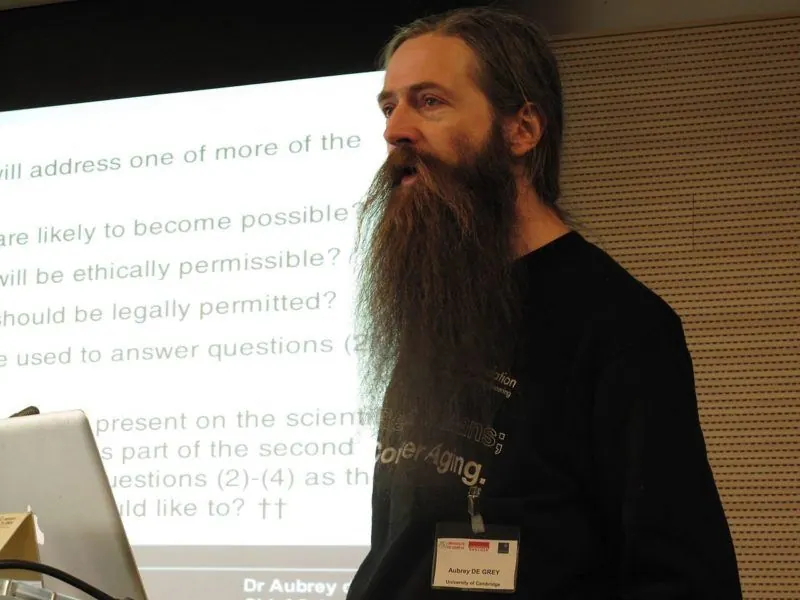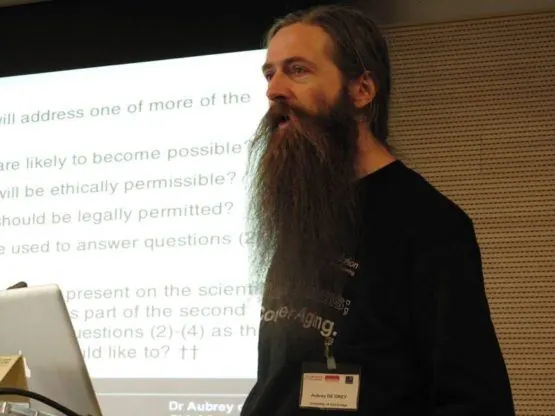Dr. Aubrey de Grey from the SENS Research Foundation (SRF) did an Ask Me Anything on Reddit on December 7th, and there were many great questions and answers; we thought it would be a great time to summarize some of the best ones and offer a little commentary.
What do you think were the biggest wins of the last couple of years in SENS-relevant advocacy, research, and development? What has moved the needle?
There have been lots. On the research, I would highlight our paper in Science two years ago, which shows how to synthesize glucosepane, and our paper in Nucleic Acids Research one year ago, which shows simultaneous allotopic expression of two of the 13 mitochondrial genes. Both of those projects have been greatly accelerated in the meantime as a result of those key enabling breakthroughs; watch this space.
On advocacy, I think the main win has been the arrival of private capital; I would especially highlight Jim Mellon and his Juvenescence initiative because he is not only a successful, energetic and visionary investor, he is also a highly vocal giver of investment advice.
We are pleased to have been involved with the second project mentioned here, as we hosted the MitoSENS project at Lifespan.io, where it raised 153% of its initial fundraising goal. Less than a year later, after raising this money, it went on to publish the groundbreaking study showing that backup copies of mitochondrial genes could indeed be created in the nucleus. Dr. de Grey originally proposed the idea over a decade ago amid much scepticism; it is really good to see that years later he has been vindicated. This is the power of crowdfunding and how we as a community can make big changes in science by working together.
How do you feel about the impact of groups like LEAF advocating and reporting on rejuvenation biotech? Has the advocacy and reporting of these groups made your life any easier?
Massively! A huge thing that I say all the time is that advocacy absolutely relies upon the diversity of its messengers. Different people listen to different forms of words, different styles of messaging, etc. The more, the better.
It’s good to know that our work is appreciated and helping. Working together as a community is essential for progress, so it was nice to see this question and response from someone we respect a great deal.
We have said many times before effective advocacy efforts are just as important as the research itself. Professional advocacy has the potential to increase public support and funding, paving the way for the arrival of rejuvenation biotechnology. In the past decade or so, advocacy has mostly been left to volunteers and people such as Dr. de Grey.
Popular causes attract celebrities, public support, funding and investment; if we want a revolution in medicine and how we treat aging, then we must popularize the movement. There has been a serious shortage of full-time and organized advocacy; therefore, we decided to create LEAF to support groups like the SRF, advocate to popularize the cause, and help to raise much-needed funds for research efforts. We are only able to do this thanks to the support of the community, and we are extremely grateful to our Lifespan Heroes for helping us to do the work we do.
Aside from funding, what do you consider to be a burden or delay for your type of research?
Nothing. Seriously, nothing at all. We have the plan, and we have the people. It’s all about enabling those people by giving them the resources to get on with the job.
Indeed, funding for research is one of the four major bottlenecks slowing down the development of therapies that address the aging processes. The more funding the field gets, the more projects can be launched, the sooner breakthroughs can potentially happen, and the greater the benefits will likely be for all of us.
Is there anything new you are able to say about the breaking of cross-links in the extracellular matrix?
Absolutely. Short story, we now have a bunch of glucosepane-breaking enzymes, and we are within a few months of spinning the work out into a startup.
A suspected cause of degenerative aging is the accumulation of sugary metabolic wastes known as advanced glycation end-products (AGEs). These are wastes that are, in some cases, hard for our metabolism to break down fast enough or even at all. Some types, such as glucosepane, can form cross-links, gumming together important proteins such as those making up the supporting extracellular matrix scaffold.
The properties of elastic tissues (skin and the blood vessel walls) derive from the particular structure of the extracellular matrix, and cross-links degrade that structure, preventing it from functioning correctly. AGEs’ presence contributes to blood vessel stiffening with age, and it is implicated in hypertension and diabetes.
That SRF now has candidate enzymes is very significant because it means that there are now potential ways to remove these crosslinks from our tissues. There are many types of crosslinks, and we already know of compounds and drugs that can break other kind of crosslinks; the major problem is glucosepane, as it lasts a very long time, and, so far, nothing is known to remove it. Given that other types of crosslinks can be removed, Dr. de Grey rightly thought that there must be ways to remove (cleave) glucosepane from tissues; now, it seems that we are a step closer to that potentially becoming a reality.
If the SRF is successful in finding ways to break glucosepane crosslinks, this has huge implications for diabetes, hypertension and aging. It is great to hear that the organization is now reaching the point at which it is almost time to develop this as a therapy by creating a startup company.
It seems likely that artificial intelligence will be a necessary tool in order to reach longevity escape velocity. I was wondering how much of a role does artificial intelligence play in your research? Is this something you devote many resources to?
We don’t, but that is because other major players in this field (and good friends of mine), such as Alex Zhavoronkov and Kristen Fortney, are doing it so well already (with Insilico Med and BioAge, respectively). Check out the BioData West conference that will occur in SF a couple of days before our Undoing Aging conference in Berlin; I will be chairing a session on this.
We believe that the application of AI and, in particular, machine learning will prove to be a very valuable tool for research in the coming years. Such systems are ideally suited for high-throughput, laborious tasks that also require high attention to detail and would take humans a long time to do. Drug discovery, image analysis and many more tasks in the lab could potentially be automated, saving time and freeing up researchers to work on other critical tasks.
We are proud to have hosted the MouseAge project this year, which is an AI-based visual aging biomarker application that helps researchers determine the age of mice without the use of harmful tests. In a few months, researchers will be able to use the MouseAge application in the lab to help speed research progress up. This is just one example of how AI can be used in aging research and how the community helped to make it happen.
Given current funding, how far away from robust mouse rejuvenation do you think you are?
My estimate is 5-7 years, but that’s not quite “given current funding”. My overoptimism in saying “10 years” 13 years ago consisted entirely of overoptimism about funding – the science itself has not thrown up any nasty surprises whatsoever – but, nonetheless, I am quite optimistic as of now about funding, simply because the progress we have made has led to a whole new world of startups (including spinoffs from the SENS Research Foundation) and investors, so it’s not only philanthropy anymore. Plus, the increase in overall credibility of the approach is also helping to nurture the philanthropic side. We are still struggling, that’s for sure, but I’m feeling a lot surer that the funding drought’s days are numbered than I felt even two or three years ago.
Robust mouse rejuvenation (RMR) has long been a goal for the SENS Research Foundation, going back to when the SENS approach was initially proposed. RMR was originally outlined as being able to demonstrate and replicate SENS to double the remaining life expectancy of an already aged mouse. This would not mean the first RMR would be a total implementation of all the SENS approaches or that rejuvenation would need to be absolute; it would be a first pass to demonstrate the viability of multiple SENS approaches combined to produce robust results.
Being able to achieve a first-pass RMR could do much to convince academia that the repair approach to aging is plausible and attract more funding and interest in the approach. While RMR working in mice may not sound that exciting, it has huge implications for the field and potentially the rate of funding and progress.
How confident are you still in your previous prediction that humans will be able to control aging by 2029?
I think we’ve slipped a few years, entirely because of lack of funding. The tipping point will be when results in mice convince a critical mass of my curmudgeonly, reputation-protecting expert colleagues that rejuvenation will eventually work, such that they start to feel able to say so publicly. I think that’s on the order of five years away.
We think that the tipping point could well be if senolytics have the same result in humans as they have in mice. Enhanced tissue repair and regeneration in older people would be a very strong case for the repair approach to aging and almost certain to convince the academics sitting on the fence.
Certainly, if AGE breakers could be demonstrated to work in humans, this would also go a long way towards not only convincing academia but also grabbing public interest. Removing AGEs from the skin may potentially reverse wrinkles, for example, and restore skin elasticity, offering a very visual demonstration of repair being plausible.
There is almost certainly going to be a tipping point at which the bulk of academic and public support swings in favour of a repair approach to aging; the only question is when? Well, the sooner the basic science can be done and moved to translational research, the sooner we can all potentially benefit from these technologies. This makes supporting both the research and advocacy of rejuvenation biotechnology very important for progress.




